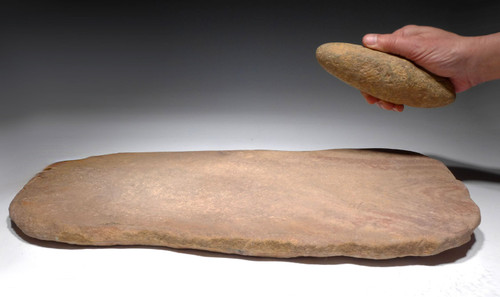Product Description
This NEOLITHIC OF CAPSIAN TRADITION artifact was found on an exposed African Neolithic site in the Sahara Desert in Northwest Africa. It was made and used by African Neolithic humans (Homo sapiens sapiens) between 10,500 and 6,500 years ago.
This is a VERY RARE COMPLETE stone grinding mill basin and rubbing stone used by Neolithic people from this period to grind substances such as grain for food, roots or herbs for medicinal uses, or pigments for body paint or rock art drawing. Rarely available on the market, this is an essential centerpiece of any collection of this Neolithic culture as this is what the Neolithic was all about - PREPARING food from cultivated / domesticated crops instead of relying on gathering naturally-occurring plants for food. It also is an iconic object from Neolithic societies as this was the first time in human history when people no longer needed to move with their resource, instead staying in one area and building a community. Objects like these indicate a sedentary life since their transportation would have not been practical.
While most grain grinding mills are larger than this example, it is intriguing to think this was probably not used for food production. It was most likely used for medicinal substances or for creating art pigments. The stone basin was fashioned out of sedimentary sandstone and shows desert exposure wear and patina as well as mineralized sediments still attached. The grinding side is slightly concave from use and shows stone pecking to have formed it, across the entire surface. The underside was left raw with natural outer stone layers still intact. The circumference was also shaped by stone pecking as seen by the pocked marks on the entire edge. The rubbing stone was made from quartzite and is pill-shaped with the underside worn flat from prehistoric use. Both, the grinding basin and rubbing stone are INTACT.
These Capsian Neolithic mills have become so rare because they are large and extremely obvious when seen in the open desert. They stand out from anything else and are easily recognizable when exposed. For many, many decades, Saharan nomads and explorers have been scouring the desert and the majority of these mills have been picked up long ago. Hence, their extreme scarcity today.
This NEOLITHIC CAPSIAN artifact was found on an exposed African Neolithic site in the Sahara Desert in Northwest Africa. It was made and used by African Neolithic humans (Homo sapiens sapiens) between 8000 and 2700 BC.
WARNING: Authentic large African Neolithic mills have become terribly rare in today's market. Their large size have made them easy to spot by nomads and all of the Northern Sahara has been picked clean of these Neolithic mills over the past 20 years. In auctions, online sellers, shows and Ebay, fakes dominate the market. In our travels to North Africa as far back as 15 years ago, we saw a tremendous quantity of convincing fakes being produced for the collector market. One way to tell is to wash the mill off with liquid dishwasing soap, boiling hot (to remove the grease and fat that fakers use to bond the dirt), water and a scrub brush. True mills with thousands of years of impacted sediment, wind erosion and mineral encrustations, will be impossible to scrub clean and under magnification, will have deep MICROSCOPIC crevices stained and impacted with minerals. Fakes will not have this. The sheer number of fake stone tools being produced in Morocco, Mali, Mauritania and Algeria, for example, is staggering, and this junk routinely makes its way to the market every year.
 US DOLLAR
US DOLLAR
 EURO
EURO
 AUSTRALIAN DOLLAR
AUSTRALIAN DOLLAR
 CANADIAN DOLLAR
CANADIAN DOLLAR
 POUND STERLING
POUND STERLING
























